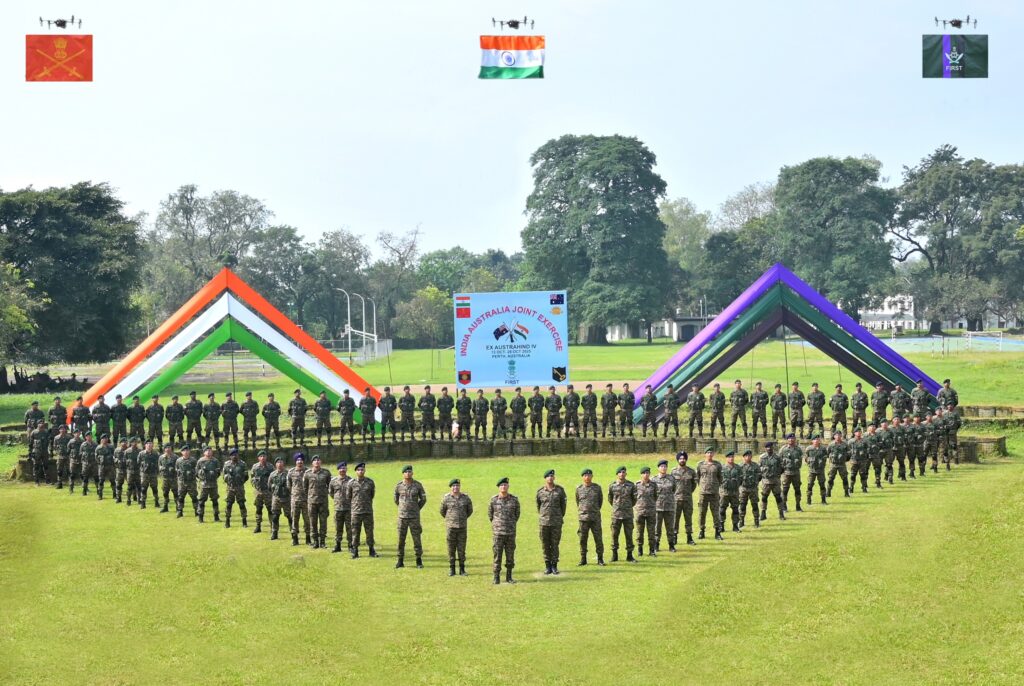AUSTRAHIND 2025: Forging Ironclad Ties in the Face of Hybrid Threats
The fourth edition of the India-Australia joint military exercise, AUSTRAHIND 2025, kicked off on October 13 in Perth, Australia, running through October 26 with a laser focus on counter-terrorism amid escalating Indo-Pacific tensions. Involving 120 troops from the Indian Army’s Gorkha Rifles Battalion alongside Australian Special Forces, the drills simulate urban sieges, drone swarms, and cyber intrusions—drawing direct lessons from Operation Sindoor’s precision ops against terror havens in May 2025. This iteration introduces AI-driven C4ISR (Command, Control, Communications, Computers, Intelligence, Surveillance, and Reconnaissance) integration, elevating interoperability under the Quad framework. As Australia’s AUKUS commitments reshape regional balances, AUSTRAHIND underscores India’s role as a net security provider, with joint patrols previewing Malabar 2026 expansions. Valued at ₹500 crore in shared tech transfers, the exercise not only sharpens tactical edges but erects a bulwark against non-state actors spilling from Afghanistan’s instability into the IOR.
Evolution of a Strategic Lifeline
Instituted in 2022 at Rajasthan’s Mahajan field firing range, AUSTRAHIND has evolved into an annual cornerstone of bilateral defense ties, alternating venues between the two nations—2023 in Perth, 2024 in Pune, and now back Down Under at Irwin Barracks. The 2025 edition, hosted by the Australian Army’s 13th Brigade, amplifies its scope with 240 participants total, emphasizing sub-conventional warfare in urban/semi-urban terrains under UN Chapter VII mandates. Indian troops, led by Lt. Col. Rajesh Thapa of the 5/8 Gorkha Rifles, arrived on October 12, integrating personnel from artillery, signals, and engineers—mirroring the multi-domain ops that defined Sindoor’s success in neutralizing 15 terror launchpads with zero friendly losses.
The exercise unfolds in two phases: combat conditioning and tactical drills (October 13-20), followed by validation exercises (October 21-26). Key scenarios include establishing Joint Operations Centres (JOCs), helipad seizures, search-and-destroy missions, and counter-drone tactics against swarms mimicking ISIS-inspired threats. Drawing from Sindoor’s real-world playbook—where Indian forces employed loitering munitions to dismantle a 200-strong militant cell—AUSTRAHIND tests hybrid warfare responses, blending kinetic strikes with non-lethal crowd control. Australian Maj. Gen. Greg Bilton, overseeing the event, noted, “This isn’t just training; it’s forging a shared shield for the Indo-Pacific.”
Tech Fusion: AI and C4ISR in the Spotlight
AUSTRAHIND 2025 marks a quantum leap with the debut of AI-enhanced C4ISR systems, a ₹500 crore tech-sharing pact under the India-Australia Comprehensive Strategic Partnership (CSP). Indian contingents deploy DRDO’s Akashteer air defense network and indigenous UAVs like the Rustom-2, synced with Australia’s Loyal Wingman drones for real-time intel fusion. Simulations pit forces against cyber intrusions disrupting command nets—echoing Sindoor’s EMP-hardened comms that sustained ops amid jamming attempts. AI algorithms, co-developed by Tata Consultancy Services and Australia’s DST Group, predict threat vectors with 85% accuracy, optimizing troop deployments in cluttered urban grids.
This integration aligns with Quad imperatives, previewing trilateral AI protocols for Malabar 2026. As per a joint statement, the exercise facilitates “seamless data interoperability,” with India exporting Akash-NG SAM tech worth ₹200 crore. Post-Sindoor validations showed such systems slashing response times by 40%, a metric now stress-tested in Perth’s semi-desert mocks. Emerging tech like quantum-secure links addresses hybrid threats from state proxies, ensuring resilient ops in contested environments.
Geopolitical Stakes: Quad’s Vanguard Against Flux
In the shadow of Afghanistan’s post-2021 chaos, where Taliban-linked groups eye IOR spillovers, AUSTRAHIND fortifies a Quad-led deterrence architecture. China’s grey-zone encroachments in the South China Sea and AUKUS’s nuclear sub push heighten the need for like-minded allies. The exercise counters this by honing CT ops tailored to non-state actors, from Lashkar-e-Taiba remnants to Houthi-style disruptions in sea lanes. India’s net security provider mantle shines through, with Gorkha riflemen sharing mountain-warfare expertise from Ladakh frictions, while Australians impart littoral maneuver lessons from Timor Sea patrols.
Bilateral gains extend to policy: Recent 2+2 dialogues unlocked ₹300 crore in loitering munition co-production, with L&T and Thales Australia leading trials. As Raksha Mantri Rajnath Singh emphasized during his October 2025 Sydney visit, “We stand at a pivotal juncture—not as partners, but co-creators of Indo-Pacific security.” AUSTRAHIND’s outcomes will feed into the Quad Summit, eyeing expanded patrols in the Malacca Strait. Analysts at ORF project a 25% interoperability boost, deterring adventurism from Beijing to Kabul.
Boots on Ground: Stories from the Frontline
Amid the drills, human elements bind the forces. On October 15, Indian and Australian troops bonded over a cultural excursion to Perth’s Swan Valley, swapping tales of valor—Gurkha kukri charges evoking Anzac legends. Cpl. Aarav Singh, a signals specialist, recounted, “Sindoor taught us chaos is opportunity; here, AI turns it into precision.” Australian Sgt. Liam Harper added, “Their resilience in hybrid fights? Game-changing for our Pacific ops.”
Validation phase highlights include a 48-hour urban siege sim, where fused C4ISR neutralized 90% of mock threats. Social initiatives, like joint yoga sessions and barbecues, foster the “camaraderie quotient,” vital for sustained alliances. With women officers comprising 15% of the Indian contingent, AUSTRAHIND advances gender parity in CT roles.
Horizons: From Perth to Pacific Primacy
Challenges persist: Harmonizing doctrines amid doctrinal divergences, like India’s emphasis on massed infantry versus Australia’s tech-centric approach, tests adaptability. Logistical strains from transoceanic deployments underscore the need for forward basing. Yet, AUSTRAHIND’s blueprint promises ripple effects—AUSINDEX maritime tie-ins and Pitch Black air drills in 2026.
By October 26, as flags lower at Irwin Barracks, AUSTRAHIND 2025 will have etched deeper trust, arming Quad partners against hybrid shadows. In an era where threats blur lines—from cyber to caliphates—India and Australia’s ironclad ties herald a fortified Indo-Pacific, where cooperation isn’t optional, but existential.




Pingback: From Perth to Panaji: AUSTRAHIND 2025 Lessons Fuel Quad Maritime Drills - DefenceNiti.com